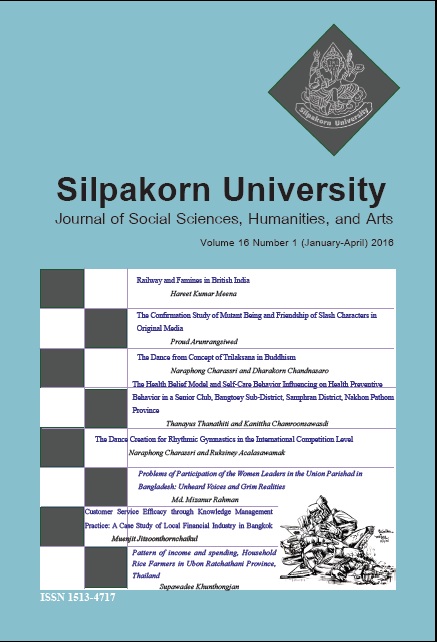Pattern of income and spending, Household Rice Farmers in Ubon Ratchathani Province, Thailand
Main Article Content
Abstract
Rice is one of the main foods and sources of nutrition for Thai citizens and much of the world’s population. As globalization influences economics and household rice farmers, this research aims to (1) compare self-adjustment for production processes and for living between rice farmers whose income is less than or equal to the average and the ones whose income is greater than or equal to the average, (2) compare self-adaptation to reduce expenses between farmers whose income is less than or equal to the average and the ones whose income is greater than or equal to the average, and (3) study effective factors on spending pattern of household rice farmers for making a living. The sample size was determined using the method of Krejcie and Morgan with simple random sampling. The study was conducted for one year and looked at a population of 384 of rice farmers. The research tool was questionnaires. Collected data was analyzed using frequency, percentage of income and expense, and a t-test. The comparative results of effective factors to change the spending pattern of household rice farmers for making a living were analyzed using the Tobit model. The findings were that (1) self-adjustment of farmers by cultivating industrial crops showed a statistical significance of 0.05. Farmers whose income is greater or equal to the average were better self-adjusted than those whose income is less than or equal to the average. Self-adaptation for making a living with supporting money from a descendant was 0.01 of statistical significance, (2) self-adaptation for reducing expense by looking for food from natural resources had a statistical significance of 0.01 with farmers whose income is less than or equal to the average better self-adjusted than the ones whose income are greater than or equal to the average, and (3) effective factors on spending patterns of household rice farmers were dependent on the gender of the household head. That is, if the household head is a man, its income and spending pattern will be reduced. When household rice farmers can make more money, their income and spending pattern will be less with statistical significance 0.05.
Downloads
Article Details
All rights reserved. Apart from citations for the purposes of research, private study, or criticism and review,no part of this publication may be reproduced, stored or transmitted in any other form without prior written permission by the publisher.
References
Department of Rice. (2012) Rice Knowledge Bank. [Online URL: https://www.brrd.in.th/rkb/] accessed on May 12, 2013.
Pranee, C. et al. (2007) Following in my father’s footsteps (King of Thailand): The Management of Agricultural Network that based on Sufficiency Economy to Solve the Poverty Sustainably. Research Paper by Thailand Research Fund.
Economic Research. (2011) The Study on Occupational Structure and Agricultural Adaptation of Rice Production and Farmers in the Repetitious Flooding Areas in the Lower Northern Region.
Faculty of Social Science, The Graduate School Kasetsart University. (2006) The Study on Poverty of Farmer. Research Paper by Economic and Agricultural Household Research Division, Bureau of Agricultural Economic Research.
Krejcie, R. V. and Morgan, D. W. (1970) Determining Sample Size for Research Activities. Education and Psychological Meaasure-ment 30(3): 607-610.
Yimsiriwatthana, N. (1998) Report Research. The analysis of household consumption behavior Central. Ramchamhang University
Research Paper by Economic and Agricultural Household Research Division, Bureau of Agricultural Ubon Ratchathani Statistic Office. (2013) History of Ubon Ratchathani Thailand. [Online URL:
https://ubon.nso.go.th/ubon/about/GeneralUbon1.html] accessed on October13, 2013
Ubon Ratchathani Provincial Agricultural Extension Office. (2013) [Online URL: www.ubonratchathani.doae.go.th] accessed on October 13, 2013
Wiboonpongse, A. (2006) Applied Econometrics for Agricultural Marketing. Faculty of Agricultural Chiangmai University.
Wiboonpongse, A. (2012) Econometric modeling for the analysis of household informal personal debt and building warning indicators towards policy formulation to manage and prevent the debt based on sufficiency economy philosophy. Final report of National Research Council of Thailand (NRCT).
Yodprudtikan, P. (2007) What is Sufficiency Economy? Bangkok: Thaipat Institute.


